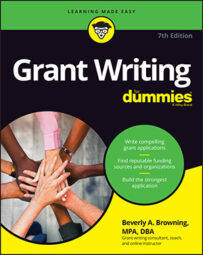If you don’t do this homework, you’re never going to access the road that leads to building an initial and lasting relationship with potential funders. Don’t be a time waster by trying to skip protocol — unless of course you actually want to commit grant-seeking suicide (this means never receiving a grant award)!
Understanding the time and effort required
How do you set up your search? Start by writing down every possible descriptor of your project and its target population (who will benefit or be served). Then begin researching those keywords and fishing for clues in the resulting links. Sometimes the links returned by the search engine can be misleading, so you have to click through to see whether your hit is a relevant funding lead for your project. Time consuming? Yes! This is a daily process that can take upward from 10 to 30 days working with keywords and possible link leads for an hour or two at a time.It’s also a good idea to start flushing out your program description and objectives even before actually having a specific grant-funding opportunity available. This will also help you to further hone your keyword search skills when you’ve got a document that you can extract keywords from.
Not all potential funders become actual funders, and you don’t want to spend 9 to 12 months counting on yeses from only one or two funders only to have them respond with a no. If you need up to $25,000, you must search for at least 5 potential funders. For up to $50,000, search for at least 10 possible funders, and for needs of up to $100,000, search for 20 potential funders. For amounts of more than $100,000, be sure to have at least 25 to 30 names on your list of possible funders.
Subscribing to helpful funding alert resources
After doing Internet searches, the next best tactic is to subscribe to e-newsletters that contain private-sector funding alerts. These give you the inside scoop on what private-sector funders are currently funding. Some great e-newsletters are the Philanthropy News Digest and the RFP Bulletin, both of which are produced by the Foundation Center.Here are some additional ways to set yourself apart from the grant-seeking bunch:
- Review each funder’s online resource materials to help you tailor your grant application to the funder’s current interest area. This refers to grant application guidelines and an annual report (which contains financial information on the funder and usually a section on previous grants funded).
- Look for lists of previous grantees on the funder’s website. This list can tell you how much the funder funds, whether grants have been awarded in your geographic area, and whom the funder has invested grant monies in (look for grantees similar to your own grant applicant organization).
- Email each funder to inquire about grant writing guideline updates that may not be posted on the funder’s website yet. It’s always possible they exist; asking never hurts. Be sure to keep your email focused on guideline updates, though. Don’t ask for money or write endless paragraphs about your organization.
- Follow to a T all the directions provided by the funding source on how to apply for grants. If you get one item wrong, your proposal can be disqualified, even if everything else is golden.
There are some pitfalls to avoid when grant seeking:
- Don’t rely on outdated print (hard copy) funding publications or websites for current contact information. Don’t use anything older than one year (scroll down to the bottom of a website’s homepage to see the date it was last updated). Current information is crucial because funders don’t forward snail mail or email when a key contact person is no longer working for them.
With snail mail, if you address your funding request to the wrong person, you simply get it back stamped return to sender. With email, you may get a message that this person is no longer with the funder, or you may not get any notice. So although you think you’ve initiated the first step to build a relationship with a program officer or foundation director, your mail is hanging out unread in some dormant email system.
Save embarrassment by calling for the current contact person, the correct spelling of the person’s name, and the correct position title. Most importantly, ask how the person prefers to be addressed: Mr., Mrs., or Ms. Double-checking the email address doesn’t hurt, either.
- Don’t look for national funders before you start to contact local funders. Look for money at home first. Check sources in your own community and county. You have a better chance of getting your first grant award from a funder that already knows about your organization.
- Don’t call the funding source with a dozen questions before you read its grant application guidelines. If you have new questions about instructions or information not found in the grant application guidelines, feel free to call. However, don’t call repeatedly with questions that the guidelines answer.
If you decide to call, make sure to jot down some notes about the call and the person you speak with. Write down her name and title, the date and time of the call, and what you discussed. Having a contact at the funder’s office can help if your grant application is rejected and you want the inside scoop on why.
- Don’t write a grant application or proposal without having completed extensive research. Know what your targeted funders fund — their grant-making priorities — and only submit requests that meet their current interests.
- Don’t broadcast your funding sources to colleagues working for other nonprofits. Keep in mind that you’re competing for funding. Learn to treasure, or keep quiet about, your findings, lest others apply as well and lessen your chances of winning.

